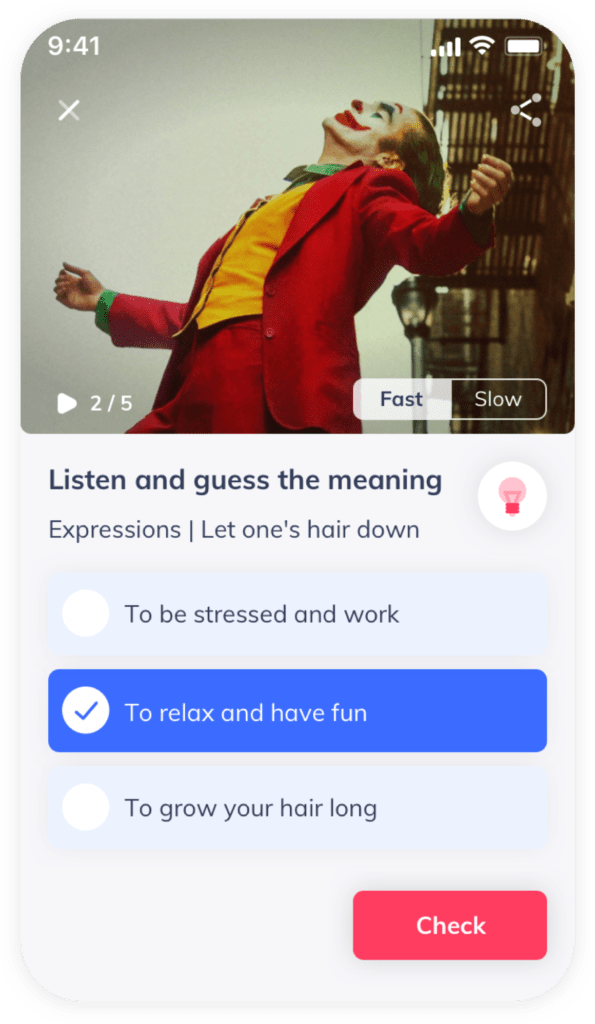Have you ever wondered if it is possible to learn English with Netflix?
Wannalisn can help because it teaches English through clips from popular Netflix movies and series to provide you with a unique learning experience that combines education with entertainment. Walt Disney himself was a firm believer in education through film and television and used the term ‘Edutainment’ as early as 1954.
Watching TV shows is a great way to improve your English because it is fun and interesting, just like the new Wannalisn app for iOS or Android.
Netflix is the best way to learn English
- English from films and series is very natural, and is close to everyday English.
- You can hear how things are really said, and, as a result, improve your pronunciation skills.
- Watching films and series in English will help your conversational skills.
- Your listening skills will benefit greatly, and you’ll also be able to hear a variety of different accents.
- Become more familiar with the sounds of English and the rhythm of the language.
- Make emotional connections with different characters while at the same time gaining exposure to very useful colloquial speech.
- You are more likely to remember new words when they are associated with something engaging.
- As you hear the same word and expression time and time again, you will be able to deduce the meaning of the word without having to look it up in a dictionary.
Subtitles do not help
Sometimes it’s hard to understand 100% of the words when you’re watching series and movies on Netflix, and you might decide to activate the subtitles. However, reading, watching and listening is not helpful if you want to train your ear to understand more than just the general message. Furthermore, real life doesn’t have subtitles (not yet!) so getting used to them won’t help if you want to feel more confident interacting with native English speakers in the real world.
Another reason why subtitles won’t help improve your listening skills is that the English we hear in everyday life and on TV is very different to the written English we learned at school. Examples of this are contractions, and how they are really pronounced in spoken English.
Let’s look at some examples.
Could have, Would have, Should have & Might have
COULD HAVE
Native speakers use contractions all the time in spoken English. In natural speech, Could + Have becomes:
Could’ve = kudəv or kuda
WOULD HAVE
The contraction Would’ve is normally heard as wudəv. But you will also hear wuda
SHOULD HAVE
As with could and would, the L is silent here.
Should’ve = shudəv or shuda
MIGHT HAVE
This is a less commonly known contraction, and difficult to understand for many non-native speakers.
Might’ve = maitəv / maidəv / maida
Negative forms
Now let’s look at the negative forms! And remember that contractions are perfectly normal in everyday speech and in informal writing. However, if you’re writing something very formal, it’s better to avoid them.
COULD NOT HAVE
This type of double contraction is not used in writing, but is very common in the spoken form.
Couldn’t’ve = kudnəv or kudna
WOULD NOT HAVE
If you use double contractions when speaking English you will sound more natural and fluent.
Wouldn’t’ve = wudnəv or wudna
SHOULD NOT HAVE
Becoming familiar with double contractions will greatly improve your listening skills.
Shouldn’t’ve = shudnəv or shudna
MIGHT NOT HAVE
This double contraction is less common, but still useful to know.
Mightn’t’ve = maidenəv
It is important to keep in mind that if you use contractions, you’ll be more likely to hear them. As your ear becomes more accustomed to fast natural English, you’ll find that you can finally start enjoying life without subtitles.
Watching popular series and movies provides great entertainment, and using Netflix and the Wannalisn app as study tools makes for a fabulous learning experience!
Learn English with Netflix!









